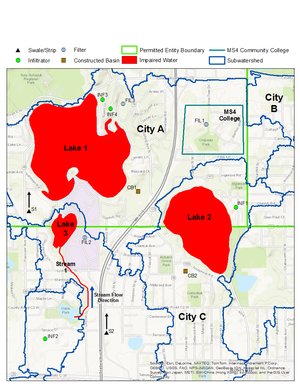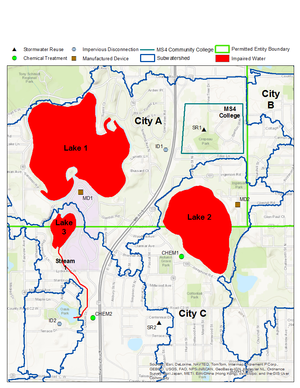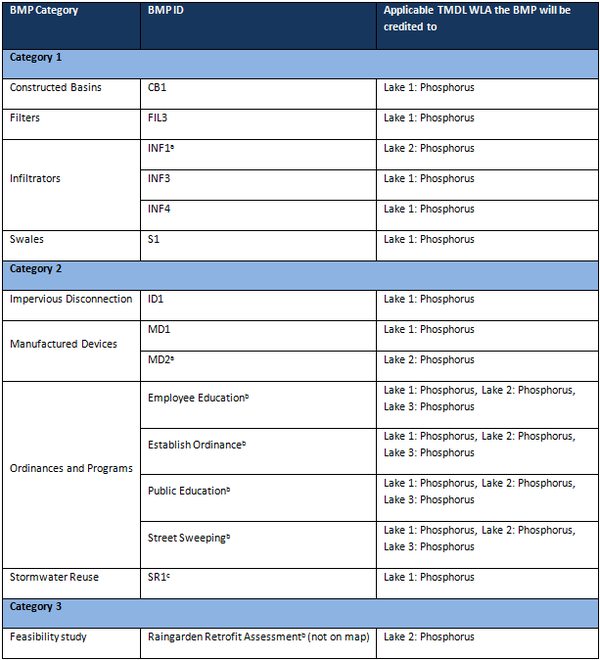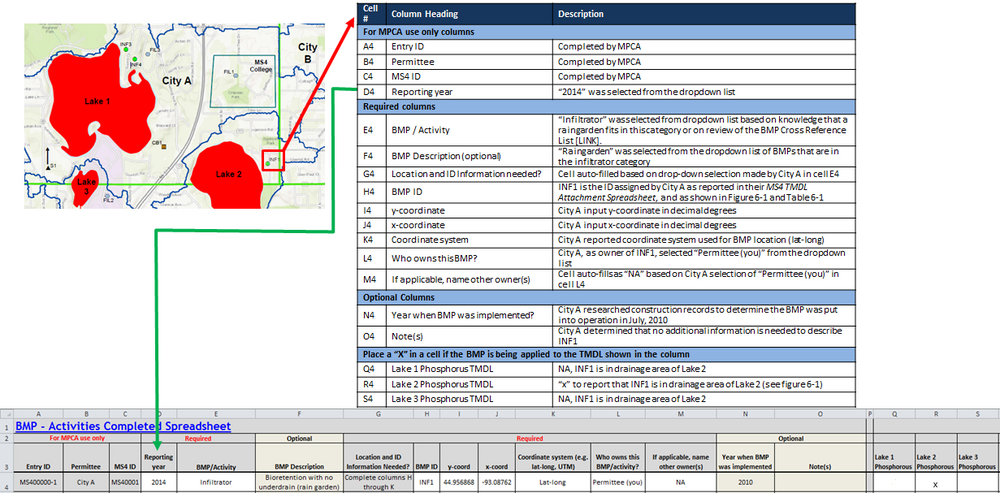
Examples for completing the TMDL reporting form
Contents
Examples for completing the TMDL reporting form
The purpose of this section is to provide step-by-step examples on how to fill out the three required tabs in the TMDL Form. These are the BMP-Activites completed tab, the Cumulative reductions tab, and the Adaptive management strategy tab. The Permittee is not required to report on every BMP/activity that has been implemented, but instead just on those BMP/activities that are being applied to applicable WLAs. Each BMP contained in the dropdown box of column E of the BMP-Activities completed tab will be covered in the examples. Please read overview of categories before continuing on with the examples.
In order to complete the TMDL reporting form, it is important that the permittee have a means to:
- Define the watersheds of applicable TMDLs
- Plot structural BMPs within their jurisdiction, and
- Determine which BMPs are treating discharges to which impaired waters
This information is provided in the figures we will be referring to throughout each example. The subsequent sections will demonstrate how to take that information and translate it to the TMDL reporting form.
Scenario 1: Metroshed WRAPS
This example set uses maps 1 and 2, which appear on the right hand side of the page. Each map covers the same area with one exception. Map 1 depicts structural BMPs and Map 2 depicts non-structural BMPs. Regardless of BMP type, the TMDLs required to be reported on are the same.
The example covers a metro area TMDL, the Metroshed WRAPS, with four MS4 permittees (City A, City B, City C, and MS4 College) and four impaired waters. The following TMDLs have been completed to address these impairments:
- Lake 1: Phosphorus
- Lake 2: Phosphorus
- Lake 3: Phosphorus
- Metroshed WRAPS: TSS
- Metroshed WRAPS: E. coli
- Lake TMDLs: Will be labeled by Waterbody + Pollutant. The title of the TMDL Project will therefore not be captured.
- Stream TMDLs: For ease of reporting, the Permittee is allowed to report on groupings of WLAs within the same report. Stream TMDLs will therefore be labeled by TMDL Project Name + Pollutant. For example, if the Permittee has TSS WLAs on four stream reaches in a single project, these will be grouped into one TMDL to report on. If the Permittee has been assigned WLAs for bacteria (whether they are expressed as fecal coliform or E. Coli) on the same four stream reaches in the same project, the Permittee would have two TMDLs to report on. Note that a Permittee may request to have the form customized to allow for individual reach reporting, however, the grouping convention will be the default.
BMP-Activities completed worksheet
City A
City A has been assigned WLA for three of the five TMDLs included in the Metroshed WRAPS project:
- Lake 1: Phosphorus
- Lake 2: Phosphorus
- Lake 3: Phosphorus
As noted in the previous section, the baseline year for each TMDL is 2010. Since the baseline, City A has implemented 14 BMP/activities that can be credited as progress toward achieving an applicable WLA. Note that all 14 BMP/activites do not apply to each TMDL WLA. Table 1 illustrates which TMDL each BMP can be credited to and in what category. See Map 1 to for location of Category 1 BMPs and Map 2 for location of Category 2 BMPs. You will notice that there are four BMPs (employee education, establish ordinance, public education, and street sweeping) listed under Category 2 that are not located on Map 2. This is simply because they cannot be associated with a single point within the watershed. Also of note is the record under Category 3. Category 3 BMPs will not be translated to the BMP-Activities completed tab. These are activities that constitute progress, which meets the permit requirement for a given year, but cannot be associated with a reduction in pollutant loading.
Table 1
a INF1 and MD2 were constructed as a joint project between City A and City B
b These BMPs do not appear on the maps because they are not associated with a discrete location
c SR1 is owned by MS4 College, but City A contributes to maintenance
Figure 1 This figure demonstrates how information for one BMP, in this case INF1, would be input to the TMDL form by City A.
City A would continue this process until all appropriate BMPs from Table 1 have been translated to the BMP-Activites completed worksheet. When completed, City A's BMP-Activites completed worksheet should look like the following screenshot.
File:BMP Activities Completed Tab for City A.png
City B
City B has been assigned WLA for two of the five TMDLs in the Metroshed WRAPS project:
- Lake 1: Phosphorus
- Lake 2: Phosphorus
Since the baseline of the TMDL, City B has implemented four BMP/Activities that can be credited as progress toward achieving an applicable WLA. As depicted on Map 1, no structural BMPs are constructed within City B's jurisdiction. However, City B has collaborated with other MS4 permittees on the following projects:
- Provided funding to MS4 College on FIL1 for the Lake 1: Phosphorus TMDL, and
- Shares responsibility with City A for maintenance of MD2 (note that shared responsibility of maintenance can constitute a partnership between MS4s but continued maintenance of BMPs is a core permit requirement and cannot be used to demonstrate progress on a yearly basis)
City B may also record their supplemental street sweeping program because they do sweeping within the Lake 1 and Lake 2 watersheds. All BMPs listed in table 2 must therefore be recorded as a Category 2 reduction unless the permittee can reasonably demonstrate an appropriate method for quantifying it in Category 1.
Table 2
a These BMPs do not appear on the maps because they are not associated with a discrete location
Screenshot of completed BMP-Activities completed tab
City C
City C has been assigned WLA for all five TMDLs included in the Metroshed WRAPS project:
- Lake 1: Phosphorus
- Lake 2: Phosphorus
- Lake 3: Phosphorus
- Metroshed WRAPS: TSS
- Metroshed WRAPS: E. coli
(text)
MS4 College
MS4 College has been assigned WLA for one of the five TMDLs included in the Metroshed WRAPS project:
- Lake 1: Phosphorus
(Text)






